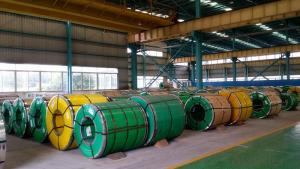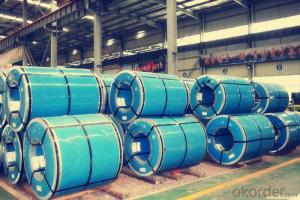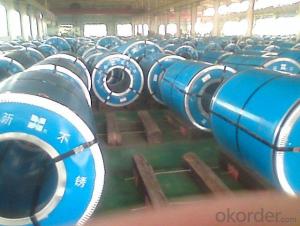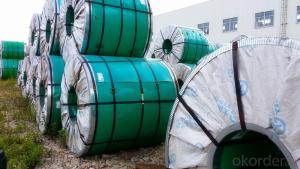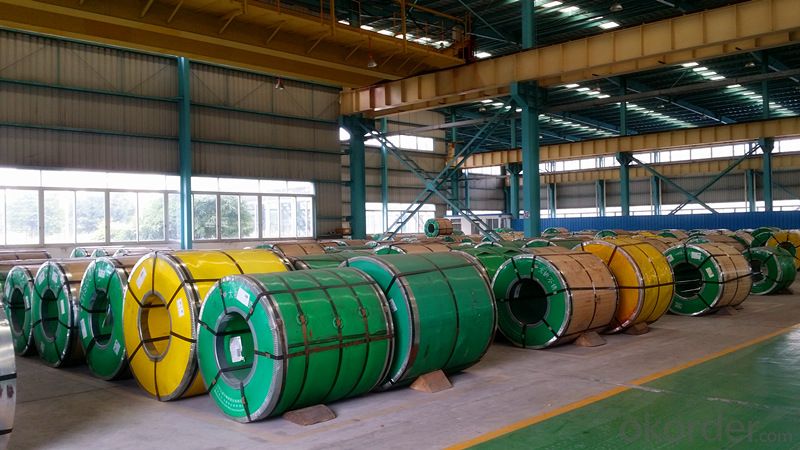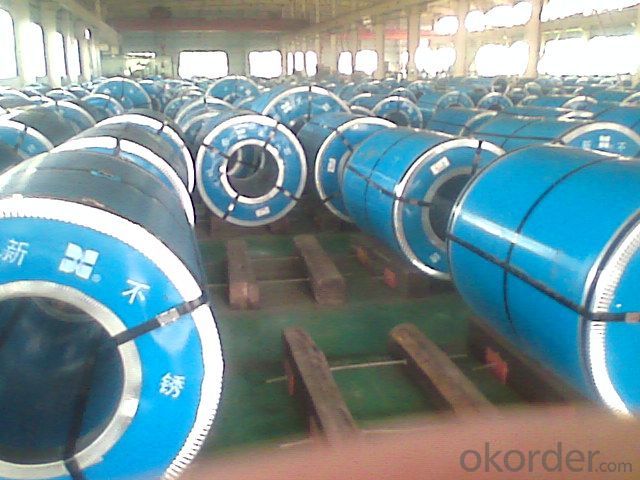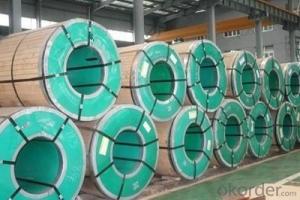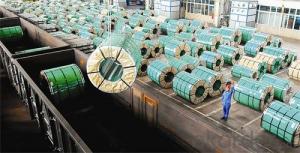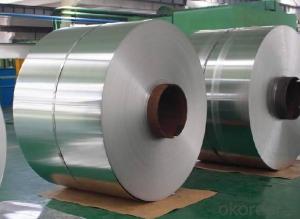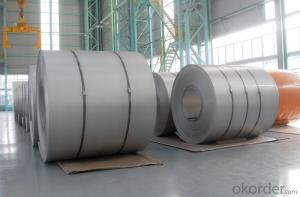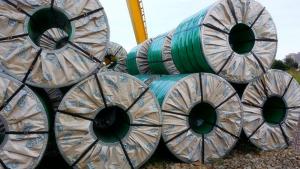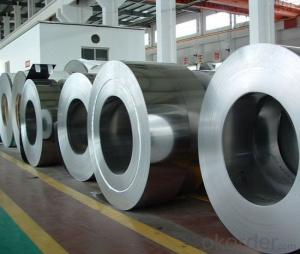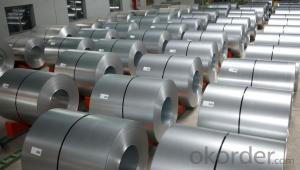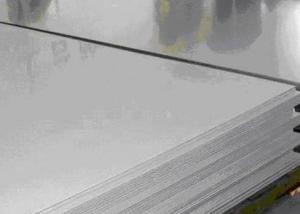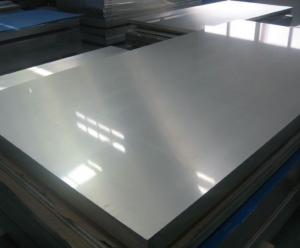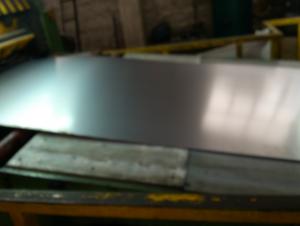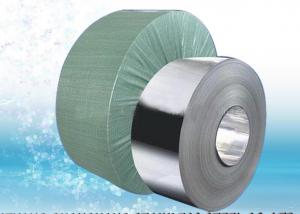Stainless Steel Coil 430 Surface No.1 Hot Rolled Coil
- Loading Port:
- Guangzhou
- Payment Terms:
- TT OR LC
- Min Order Qty:
- 100 m.t.
- Supply Capability:
- 5000 m.t./month
OKorder Service Pledge
OKorder Financial Service
You Might Also Like
Article | Hot Rolled Stainless Steel Coil 430R |
Grade | 400 series |
Specification | 1m, 1.2m, 1.5m |
Surface | No.1 |
Type | Sheet / Coil |
Width | 1000mm, 1219mm, 1240mm, 1500mm |
Thickness | 2.5mm,3.0mm, 4.0mm |
Brand name | CNBM |
Parking | seaworthy wooden pallets or wooden cases,in 20' or 40' container or as per customers' requirements |
Payment | 30% in advance,70% after shipping, or L/C at sight |
Delivery Time | Stock materials, within7-15 days after received the deposit of T/T or L/C |
Hot Rolled Stainless Steel Coil 430R No.1 Finish
- Q: Are stainless steel strips suitable for dairy tanks?
- Yes, stainless steel strips are suitable for dairy tanks. Stainless steel is a popular choice for dairy tanks due to its excellent corrosion resistance, hygienic properties, and ease of cleaning. It is also resistant to bacterial growth and does not react with milk or other dairy products, making it a safe and reliable material for dairy tank construction.
- Q: How are 111 stainless steel strips manufactured?
- The manufacturing process for 111 stainless steel strips encompasses several stages. Initially, raw materials are carefully chosen, typically including iron ore, chromium, nickel, and other alloying elements. These materials are precisely measured and blended in the desired proportions to create the stainless steel alloy. Subsequently, the raw materials are melted in a high-temperature furnace. The resulting molten metal is then poured into a continuous casting machine, which shapes it into long slabs or billets. These slabs are allowed to cool and solidify. Once solidified, the slabs are reheated in a furnace to a specific temperature, rendering them more malleable. They are then passed through a hot rolling mill, where they are reduced in thickness and elongated into long strips. The rolling process is repeated multiple times until the desired thickness and quality are achieved. When the strips reach the desired thickness, they undergo annealing in a heat treatment furnace. Annealing helps alleviate internal stresses and enhance the mechanical properties of the stainless steel. This process involves heating the strips to a specific temperature and gradually cooling them. To improve the surface finish and eliminate imperfections, the strips are subjected to a pickling process. This entails immersing them in an acid solution that removes scale, oxides, and other impurities from the surface. Following pickling, the strips undergo a cold rolling process. This involves passing them through a series of high-pressure rollers, further reducing their thickness and enhancing their surface finish. To attain the desired dimensions and tolerances, the strips are subsequently cut into the required lengths using shearing or slitting machines. Depending on the specific application requirements, they may also undergo additional processes such as edge trimming, edge rounding, or surface polishing. Finally, the finished stainless steel strips undergo a thorough quality inspection, which includes checking for dimensional accuracy, surface defects, and mechanical properties. They are then carefully packaged and prepared for shipment to customers across various industries, such as automotive, construction, appliances, and many more.
- Q: What are the common uses of stainless steel strips in the pharmaceutical manufacturing process?
- Stainless steel strips are commonly used in the pharmaceutical manufacturing process for various purposes such as secure packaging of medications, production of sterile equipment like syringes and needles, fabrication of pharmaceutical machinery and equipment, and construction of cleanrooms and controlled environments to maintain strict hygiene standards in the production facilities.
- Q: What are the common surface finishes for stainless steel strips?
- Stainless steel strips can be finished in different ways to achieve various appearances and functions. Here are some commonly used surface finishes: 1. Basic Finish: After being hot or cold rolled, stainless steel strips have a dull and non-reflective appearance, known as the mill finish. 2. Textured Finish: By brushing the stainless steel strip with abrasive materials, a textured appearance is achieved. This brushed finish helps to conceal surface imperfections and gives the strip a satin-like finish. 3. Reflective Finish: The stainless steel strip is mechanically polished, resulting in a smooth and reflective surface. This polished finish is often used for decorative purposes and is available in different levels of polish, such as mirror polish or satin polish. 4. Embossed Finish: To add texture and visual interest, the stainless steel strip is passed through embossing rollers, creating raised or sunken patterns on the surface. 5. Patterned Finish: Various techniques, like etching or laser engraving, can be used to create decorative patterns or designs on the surface of stainless steel strips. This gives the strip a unique and distinctive look. 6. Coated Finish: To enhance appearance or provide extra protection against corrosion, a thin layer of another material, such as a polymer or a metal, can be applied to the stainless steel strip. These finishes cater to different applications, offering a range of aesthetics and functionality.
- Q: Are stainless steel strips resistant to acetic acid?
- Yes, stainless steel strips are generally resistant to acetic acid.
- Q: Are stainless steel strips resistant to nitric acid corrosion?
- In general, stainless steel strips demonstrate resistance to corrosion from nitric acid. This is because stainless steel contains a significant amount of chromium, which creates a protective layer on the surface when it comes into contact with oxygen. This layer, referred to as the passive layer, effectively shields the metal from reacting with its surroundings, including nitric acid. However, it is important to consider that the level of resistance to nitric acid corrosion can vary depending on the specific alloy and the concentration of nitric acid. In certain instances, extended exposure to high concentrations of nitric acid or elevated temperatures may lead to corrosion or pitting on the surface of stainless steel strips.
- Q: Can stainless steel strips be used in medical equipment?
- Yes, stainless steel strips can be used in medical equipment. Stainless steel is commonly used in the medical industry due to its excellent corrosion resistance, strength, and durability. It is highly resistant to rust and can withstand harsh sterilization processes, making it a suitable material for medical devices and equipment. Stainless steel strips can be used in various applications such as surgical instruments, implants, catheters, orthopedic devices, and diagnostic equipment. The smooth surface of stainless steel also makes it easy to clean and maintain, ensuring the highest level of hygiene in medical settings.
- Q: Can stainless steel strips be used in the renewable energy industry?
- Yes, stainless steel strips can be used in the renewable energy industry. Stainless steel is a highly versatile and durable material that offers excellent corrosion resistance and longevity, making it suitable for various applications in renewable energy systems. One common use of stainless steel strips in the renewable energy industry is for the manufacturing of solar panels. These strips are often used as reflectors or for bonding the solar cells together due to their resistance to weathering and moisture. Additionally, stainless steel strips can also be used for framing and mounting structures in solar panel installations, providing a sturdy and reliable support system. Another application of stainless steel strips in the renewable energy industry is in wind turbines. These strips are commonly used for the construction of turbine blades, which require materials that can withstand high winds, corrosion, and fatigue. Stainless steel's strength and corrosion resistance make it an ideal choice for this purpose, ensuring the longevity and performance of the turbines. In addition to solar panels and wind turbines, stainless steel strips can also be utilized in other renewable energy technologies such as hydropower, geothermal, and biomass systems. They can be employed for various purposes such as heat exchangers, piping, and structural components, where their corrosion resistance and mechanical properties are advantageous. Overall, stainless steel strips offer numerous benefits that make them suitable for use in the renewable energy industry. Their durability, corrosion resistance, and versatility make them an excellent choice for various applications, allowing for the efficient and sustainable generation of renewable energy.
- Q: Are stainless steel strips available in different widths?
- Yes, stainless steel strips are available in different widths.
- Q: Are stainless steel strips suitable for decorative purposes?
- Stainless steel strips prove to be an excellent option for enhancing aesthetics. Renowned for its sleek and contemporary look, stainless steel is a favored choice for a wide range of decorative uses. Its surface boasts a shiny and reflective quality that effortlessly adds an air of elegance to any setting. These strips offer endless possibilities for creating decorative accents, whether it be a stylish trim, border, or even a custom design on walls, furniture, or appliances. Not only does stainless steel promise durability, but it also exhibits remarkable resistance to corrosion, making it a reliable choice for both indoor and outdoor applications. Moreover, its effortless maintenance and easy-to-clean nature ensure that its decorative qualities remain intact for years to come. All in all, stainless steel strips present a versatile and visually appealing option for decorative purposes.
Send your message to us
Stainless Steel Coil 430 Surface No.1 Hot Rolled Coil
- Loading Port:
- Guangzhou
- Payment Terms:
- TT OR LC
- Min Order Qty:
- 100 m.t.
- Supply Capability:
- 5000 m.t./month
OKorder Service Pledge
OKorder Financial Service
Similar products
Hot products
Hot Searches
Related keywords
